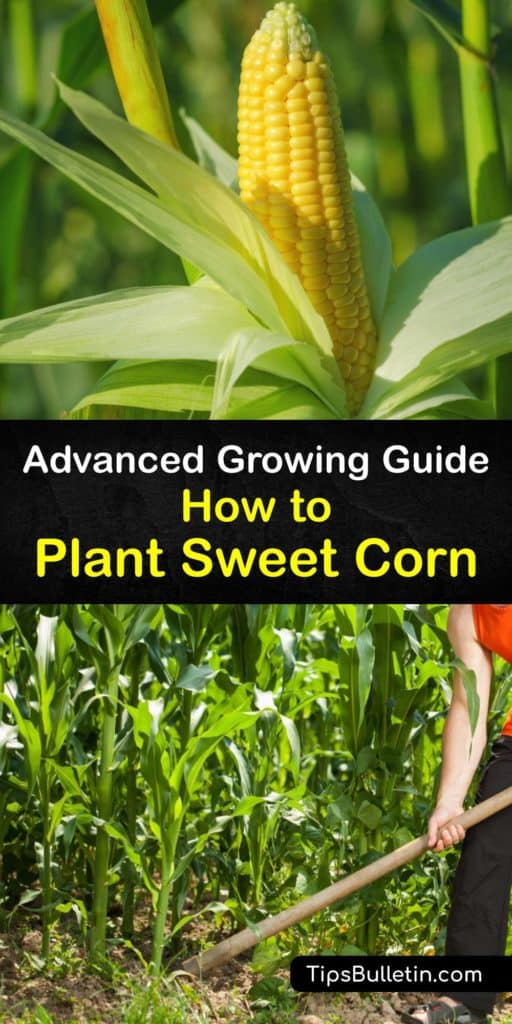If you’ve ever driven through the American mid-west, you’re familiar with the endless waves of field corn, and you know it’s nearly harvest-time once those corn plants get as tall as you. However, are you aware that you can grow sweet corn in a home garden? Learn how to plant sweet corn with the right growing conditions and care for your plants through the growing season.
Of all the garden vegetables, sweet corn is one of our favorites. There is nothing quite like biting into a corn cob and enjoying the sweetness of the kernels as they pop into your mouth. If you’ve never had fresh corn from sweet corn plants, you’re in for a treat since they’re even better homegrown.
There are many sweet corn varieties to pick from, and growing corn is easier than you may think. While these plants take up more garden space than other veggies like tomatoes, peppers, or pole beans, they are well worth the effort if you have the room.

Planting and Growing Sweet Corn
The easiest part about planting sweet corn is sowing the seed. However, these plants want the right conditions to grow and some TLC from you to flourish and produce healthy corn cobs.
There are also various problems to keep an eye out for throughout the sweet corn growing season to prevent your plants from suffering.
Find out what a corn plant needs to thrive and how far apart to plant sweet corn, whether you are growing corn in pots or the garden. Discover how to care for corn plants while growing sweet corn in a home garden and a fun recipe for fresh corn after harvest.
Growing Conditions for Planting Sweet Corn
Before planting sweet corn, we recommend learning what these plants want to grow and produce corn cobs. There are also different varieties of sweet corn to plant, and some of them are sweeter than others when it comes corn harvest time and the ears are ready to eat.

Explore the different types to help you pick the ideal corn variety and the growing conditions that corn plants require for optimal growth. If you are planning on planting corn in containers, choose a variety that doesn’t get too big.
The first thing to know about growing sweet corn is that there are many corn varieties, and some of them are better suited for home-growing. There is a great difference between sweet corn and field corn and there are three main sweet and super sweet cultivars.
SU, or sugary, is the most common, and it’s tolerant of cool weather conditions and easiest to grow at home. SH2, or supersweet corn, is a little more challenging to grow. SE types are sugary enhanced and require warm soil temperatures for production.
Golden Bantam is an SU type with stalks that only reach five feet tall, while Ambrosia Hybrid corn is an SE type, and Blue Hopi is an SH2 variety.
The growth rate of sweet corn depends on the type. Early varieties, like Nirvana, take 72 days to reach maturity, while Stowells Evergreen, an heirloom variety, takes up to 100 days to grow.
Sweet corn grows ideally in a well-drained soil amended with organic matter and a pH of 5.8 to 7.0. It loves full sun and requires regular watering when the plants are young, and the root system is not yet developed, with minimal watering once the plants establish.
How Far Apart to Plant Sweet Corn
Corn plants grow quite tall, and they need the proper spacing for healthy production. Learn how far apart to plant sweet corn to help you determine the size of your corn garden and plan accordingly.
Sweet Corn Spacing
Proper sweet corn plant spacing is essential for healthy growth, and it also protects the plants from cross-pollination if you grow different varieties. How far to plant corn apart from other sweet corn seed is about twelve inches. Space the rows at least 30 to 36 inches apart.
To have fresh sweet corn all summer long, consider staggering the planting time of different types. For example, planting corn seeds of an early variety at the start of the season, planting another early type a couple of weeks later, and then planting a late variety gives you a longer corn season.
How to Plant Sweet Corn
The best way to plant sweet corn and grow corn at home is to start them from seed. However, it’s important to wait until the soil temperature is above 55°F before you plant corn. Prepare your garden and plant corn seed with the correct depth.
Before planting sweet corn seeds, whether treated seed or untreated seed, work the top eight to ten inches of garden soil and remove rocks, weeds, and debris. Next, spread a balanced fertilizer evenly over the garden and work it into the top three or four inches of dirt.
When is the best time to plant corn? After the last frost, when the soil is at the right temperature, it’s time to sow the sweetcorn seed. Sow seeds a half-inch deep in cool, moist dirt and an inch and a half deep in warm, dry soil. Water them right after planting so that the garden is moist but not soggy.
Caring for Sweet Corn in the Garden
Once you’ve got your seeds planted and they begin germinating, it’s time to care for your corn plants to ensure they produce cobs. Nurture your corn crop by watching for problems as they mature, and discover when to harvest corn on the cob.
As your corn plants grow, water them as needed to prevent them from wilting, and do not let them struggle from lack of water as the kernels form. Use a hoe to till just under the dirt surface to remove weeds, and do not hoe too deeply to prevent cutting the corn roots.
Once the plants reach two feet tall, scatter a cup of fertilizer for every ten feet of garden row, mix it lightly into the dirt between the rows, and water the ground right after fertilizing.
Keep an eye out for the grasshopper, European corn borer, corn earworm, fall armyworm, and flea beetle. These are common corn pests that destroy crops if left unchecked. Planting resistant varieties, performing crop rotation, and using insecticidal soaps are the best way to deal with these insects and prevent an infestation.
Another issue to deal with while gardening is plant disease. While sweet corn plants are seldom seriously damaged by diseases in a home garden, there are times when they occur, and prevention is key to saving your crop.
Corn smut is a fungus that creates white or grayish galls containing spores on leaves, stems, and ears, and removing the infected areas keeps the disease in check. Rust is another disease that causes red, raised spots on upper leaf surfaces, and this issue arises when the temperatures are cool and humid.
Harvest time varies, depending on whether you grow regular sweet corn or super sweet corn. When to pick sweet corn is anywhere from 60 and 100 days after planting. Each sweet corn stalk usually produces at least one ear of corn, and when to pick corn is about 20 days after you notice signs of the first silk.
After you determine when to harvest sweet corn, grab the ear, twist it and pull it in a downward motion to snap it off the plant. It’s essential to keep the corn from drying out after harvesting, so wrap the ears in a plastic bag and refrigerate them for no more than three days for the best taste.
If you cannot eat the corn fast enough after harvesting sweet corn from the garden, consider freezing it for more extended storage. Blanch and freeze the corn kernel or freeze them raw. The best way to keep corn on the cob fresh is to place whole cobs in the freezer for up to one year.
How to Make Oven-Roasted Corn on the Cob
While the simplest way to prepare corn on the cob is to boil it, this oven-roasted recipe uses an herb and garlic flavored butter that brings out the sweetness of the kernels, and it only takes minutes to prepare.
Combine the softened butter, parsley, garlic, rosemary, thyme, salt, and pepper in a bowl and spread a tablespoon of the herb butter over each corn cob. Wrap the cobs individually in aluminum foil and place them on a baking sheet. Roast in an oven heated to 425°F for 20 minutes, turning halfway through the cooking time.
Planting sweet corn at home takes a little effort, whether you grow standard sweet corn or super sweet varieties. However, the reward is worth it since you get to reap the benefits of harvesting organic sweet corn from garden to table.

We hope that learning how to plant sweet corn provides you with sweet, buttery corn cobs at the end of the season, and we’d love it if you’d share our sweet corn planting guide with the corn-lovers in your life on Pinterest and Facebook.